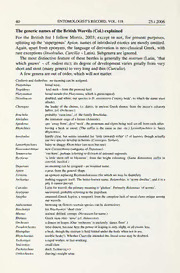
The generic names of the British Weevils (Col.) explained PDF
Preview The generic names of the British Weevils (Col.) explained
. 40 ENTOMOLOGIST'SRECORD,VOL. 118 25.L2006 ThegenericnamesoftheBritishWeevils(Col.)explained For the British list I follow Morris, 2003; except in not, for present purposes, splitting up the ‘supergenus’ Apion. names ofintroduced exotics are mostly omitted. Again, apart from eponyms, the language ofderivation is neo-classical Greek, with rareexceptions {Involvulus, Curcilio-Latin). Subgeneraareignored. The most distinctive feature ofthese beetles is generally the rostrum (Latin, ‘that which gnaws’ - cf. rodent etc); its degree of development varies greatly from very shortand stout(many genera) tovery longandthin (Curculio). A fewgeneraareoutoforder, whichwill notmatter. CimberisandAnthribus nomeaningcanbeassigned. Platyrhinus broadnose. Tropideres keelneck-fromthepronotalkeel, Platystomos broadmouth(forPlatystoma,whichispreoccupied). Dissoleucas doubled,andwhite;ourspeciesisD. niveirostris(‘snowybeak’,towhichthenamemust allude). Choragus the leaderofthe chorus, i.e. dance, in ancientGreek drama; from the insect’s saltatory habits,(cf.Orchestes.) Bruchela probably‘varacious’,cf.thefamilyBruchidae. Attelabus theimmaturestageofalocust(Aristotle). Apoderus apo‘awayfrom’,dere‘neck’,thepronotumandelytrabeingwellset-offfromeachother, Rhynchites having abeak or snout. (The suffix is the same as our -ite.) Lasiorhynchites is ‘hairy Rhynchites’ Involvulus hardlyclear,butseemsintendedfor ‘little(inward)roller’ (?ofleaves),thoughactually ourtwospeciesdevelopinberries(Crataegus,Sorbus). Lasiorhynchites hairyorshaggyRhynchites(seenextbutone), Neocoenorrhinus newCoenorrhinus(subgenusofDeporaus). Temnocerus ‘cut-horn’,perhapsreferringtodivisionofantennalsegments. Byctiscus ‘alittle show-offorblusterer’, from the bright colouring. (Same diminutive suffix in asterisk,basilisk.) Deporaus nomeaningcanbeassigned-aninventedname, Apion apear,fromthegeneralshape. Ferreria aneponymreplacingRaymondionymus(forwhichwemaybethankful). Archarius nothingsuggestsitself.Thebetter-knownname,Balanobius,is‘acorndweller’,anditisa pityitcannotprevail. Curculio Latinforweevil;theprimarymeaningis‘glutton’.FormerlyBalaninus‘ofacorns’, Acalyptus uncovered,probablyreferringtothepygidium. Anoplus unarmed(Greekhoplon,aweapon);fromthecompletelackoftarsalclawsuniqueamong ourweevils. Anthonomus browsingonflowers(certainspeciescanbedestructive). Brachonyx forBrachyonyx‘shortclaw’. Miarus stained,defiled,corrupt.(Noreasonforname.) Rhinusa Greekstemrhin-‘nose’(cf.rhinoceros). Orchestes adancerorleaper.(Our‘orchestra’isanciently‘dancefloor’.) Pseudorchestes falsedancer,becauseherethepowerofleapingisonlyslight,oralleventsless. Rhamphus abeak,thoughtherostrumisheldfoldedunderthebodywhennotinuse. Rhynchaenus terriblebeak(!).WhetherClairvilleintendedthisliteralsensemaybedoubted. Tachyerges arapidworker,orfast-working. Smicronyx smallclaw. Pachytychius thickTychius(q.v.) Orthochaetes (having)straightsetae. . NOTES 41 Pseudostyphlus ‘false’and‘hard,rugged,rough’;thesimpleStyphlusisanexoticgenus, Sibinia ahuntingspear;applicationfanciful, Tychius derivedfromtyche‘chance’;equallyfanciful. Bagous(-o-us) ‘AneunuchatthePersiancourt’(Smith’sLatinDictionary), Baris asortofraftorprimitiveboat;thegenusissemi-aquatic. Limnobaris ‘marshorlakeBaris' Amalus weak. Calosirus ‘beautifulpit’,withreferencetosomestructuralcharacter. Ceutorhynchus ‘hidden beak’, the rostrum being tucked underthe body in repose. (The first element shouldhavebeenceutho-,relatedtoour‘hide’.) Coeliodes ‘ofhollowaspect’;reasonfornameunclear, Coeliodinus formedfromthelast(verycloselyalliedtoit), Datonychus firstelementobscure,secondonyx‘anailorclaw’. Drupenatus, Ethelcus,Glocianus atrioofinventionsbyReitter. Hadroplontus stoutorstrongweapon(hoplon)plusaformativesuffix, Micrelus arbitraryextensionofmikros‘small’. Microplontus ‘smallweapon’,cf.Hadroplontusabove. Mogulones ‘troublesome,difficult’ (whichcertainlydoesnotapplytoanyofourthreespecies).The firstsyllablealonemeaningful. Nedyus ‘apaunch,belly’:thebeetleismoreconvexbeneath. Parerhelcus ‘alongsideEthelcus",aneighbouringgenus. Poophagus ‘eatingorfeedingonPoa",earlierconsideredthefoodplant. Sirocalodes ‘resemblingCalosirus’(above),withthelatter’selementstransposed, Stenocarus narrowhead. Tapeinotus humbled,broughtlow(buttheweevilisfarfromobscure), Thamiocolus firstelement‘crowdedclose’,secondapparently‘segment’, Trichosirocalus hairyCalosirus(seeabove). Zacladus ‘muchbranded’,anameofdoubtfulapplication. Mononychus (having)oneclaw(toeachtarsus)-amostunusualcharacter, Eubrychius agoodsailor,fromitssurface-swimmingcharacter. Neophytobius ‘newplant-dweller’(genussplitofffromPhytobius). Pelenomus anewnameforthefamiliarPhytobius,ofdoubtfulmeaning. Phytobius ‘plant-living’,formerlyLitodactylus. Rhinoncus ‘swollennose’,fromathickeningoftherostrum, Rutidosoma forRhytidosoma, ‘wrinkledorshrivelledbody’, Cossonus nothingclearcanbesuggested.* Rhopalomesites ‘Mesiteswithaclub’(referencetoantennaeoffemora?) Caulophilus ‘stalk-loving’(LatinplusGreek),fromitshabits. Pselactus seemstocombinetheideaofgroping(asinPselaphus)withthatoftheseashore(akte); thebeetlelivesindecayingbreakwaters. Pseudophloeophagusliterally‘falsebark-eater’. Stereocorynes solidclub,withreferencetotheantennae. Pentarthrum five-jointed(oftarsi), Macrorhyncolus longorlargeRhyncolus. Rhyncolus forRhyncholus,butsecondelementobscureorarbitrary. Phloeophagus bark-eating. Cryptorhynchus hiddenrostrum. Acalles withoutbeauty. Stemochetus probably‘withbristles(chaetae)onthebreast(sternum)’. Gronopus(=Alophus)‘writtenon’;freshspecimensareprettilyvariegated. Neliocarus itseemsbarelypossibletoextractameaningfromcompound. Strophosoma ‘roundbody’(strophos‘aturn’). 42 ENTOMOLOGISTSRECORD,VOL. 118 25.i.2006 Attactagenus forAtactogenus ‘out oforder’; perhaps meaning ‘anomalous’ but the weevil is not noticeablyso. Philopedon ground-loving. Barynotus ‘heavyback’,fromtherobustbuild. Omiamima ‘mimickingOmias’,analliedgenus. Otiorhynchus ‘snoutwithlittleears’,fromtheslightdilatationsatapexofrostrum. Caenopsis ‘newlook’;maybeinterpretedaccordingtotaste. Peritelus ‘aroundtheend’,withreferencetoscaling? Phyllobius livingonleaves. Liophloeus ‘smoothbark’;fromitsappearance. Polydrusus ‘muchdew’, assuming-drusustobeintendedfor-drosus\ theoftenlustrous scalesmay havesuggestedthename. Barypeithes hardtopersuade(tomove?) Brachysomus forBrachysoma, ‘shortbody’. Sciaphilus shade-loving. Sitona acommerchant.TheformSitoneswasmuchinuseearlier. Tanymecus ‘extendedinlength’,fromitsshape. Trachyphloeus ‘roughbark’,fromthesurfaceappearanceoftenpresented. Cathormiocerus ‘necklace-homed’,i.e.withthefunicularsegmentsmoniliform. Tropiphorus keel-bearing. Hypera seemsintendedfor‘raisedabove’,butwhy? Limobius forLimonobius,meadow-living’, Larinus fatorfatted,rich, Lixus nomeaningcanbeassigned. Bothynoderes ‘neck(pronotum)withapitorfovea’. Cleonis (Cleonusauct.) famous;cf.Greeknamesin-cles,e.g.Pericles. Coniocleonus ‘dustyorpowderyCleonus',fromthenaturaldustsecretedonthesurface. Rhinocyllus ‘bentorcrookednose’(rostrum),withtheepithetawkwardlyplacedsecond, Magdalis acrumb(notverydescriptive!), Liparus fat,rich(thesearelargeweevils), Leiosoma smoothbody. Mitoplinthus ‘threadbrick’;thereadermaymakewhathewillofthis! Anchonidium alittlehalter(butwhy?), Hylobius livingonwoodorinwoods, Lepyrus ashell,husk,orrind(reasonfornameobscure), Syagrius awildpigorboar. Pissodes resemblingpitch(ofsurfaceappearance). Trachodes appearingrough. Orobitis feedingontheplantOrobus. Scolytus anoldname,butnotclassical,andmeaningcanbeassigned, Pityophthorus pinedestroyer. Cryphalus tendingtohide(cf. ‘cryptic’), Ernoporus burrowinginshoots. Ernoporicus amereextensionofthelast,fordistinction, Trypophloeus burrowinginbark, Crypturgus hiddenworker,orworkingsecretly, Dryocoetes lyinginoaktrees. Dryocoetinus amereextensionofthelast,fromwhichitisbarelydistinct, Lymantor adestroyer. Taphrorychus agravedigger,fromtheworkingsunderbark, Xylocleptes wood-thief. NOTES 43 Ips awoodworm(likeCis). Orthotomicus straightTomicus(seebelow). Pityogenes breedinginpineorfir. Xyleborus wood-eating. Trypodendron boringintrees.(Xyloterus:boringinwood). Hylesinus wood-destroyingor-destroyer. Hylastinus anextensionofHylastes(below). Kissophagus ivy-eater. Leperisinus firstelementaninventionofReitter’s,second‘destroyer’. Pteleobius livinginorinlimetrees. Hylastes awoodmanorforester. Hylurgops resemblingHylurgus,awoodworker. Phloeotribus literallybark-rubber,i.e.damagingbark. Phloeosinus bark-destroyer,(cf.Sinodendron,Hylesinus.) Polygraphus ‘muchwriting’,fromthebroad-galleriesunderbark(fancifulresemblance). Tomicus acutter,forthesamereason. Dendroctonus tree-killingor-killer. Xylechinus ‘woodhedgehog’(somewhatfanciful). Tanysphyrus longhammer(hardlyclear). P—latypus broadfoot(butitisthetibiae,notthetarsi,thatarebroad). A. A. Allen, 49MontcalmRoad, Charlton,London SE7 8QG. , *TheeditorhassuggestedthatthenameCossonusmightbederivedfromcossus-thelarvafromunderbark eatenbytheRomansasrecordedbyPlinytheElder,c.60adinhisNaturalishistoria. Observationson adultFiery ClearwingPyropteron chrysidiformis (Esper) (Lep.: Sesiidae)insouth-westFrance Although extremely localised and afforded legal protection in the UK, Pyropteron chrysidiformis is far more frequently encountered in the western part ofEurope, its distributional range extending south to Gibraltar and east to Central Europe and including all of Italy. In the Balkans, it is replaced by the superficially similar P. minianiformis (Freyer). It is an extremely variable species, and this recently gave us some cause for concern as far as our local population at Gradde was concerned. Lastuvka & Lastuvka (2001. The Sesiidae ofEurope. Apollo Books) record wingspans in the range 17 to 26 mm. In additional to typical examples, all ofwhich had a “fiery” coloured vertex, smallerforms, with awingspan as small as 13mm and often with the head covered in entirely black scales, are occasionally encountered. Following amoth-recording trip here by Colin Plant, Phil JennerandRachel Terry, a sample ofboth sexes ofthe various forms was taken away by Colin Plant for closer investigation; all hopes of a cryptic new species were dashed when, after he had examinedthegenitalia, hepronouncedthem all tobechrysidiformis'.
